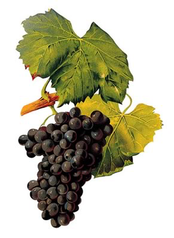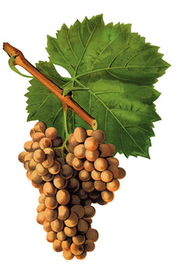As I enjoy the abundance of Grenache rosés this spring, I am again reminded about what great and distinct wines are made from this grape. Because it is often a blending grape rather than a mono-varietal star, Grenache may be the best grape variety you don’t know. Maybe I should say “Garnacha” since it is considered to be native to Spain, and it is called “Cannonau in Sardinia,” so one reason it may hold the fame it deserves is that it travels under different names. It is extremely versatile as a cultivar, both in its red and white strains (Grenache Blanc or Garnacha Blanca), that can produce many different wines: Dry red, dry white, dry and sweet rose, as well as fortified red and white. Moreover, Grenache is similar to Pinot Noir in its very broad compatibility with food. At the table, different renditions can range from muscular reds that can stare down a steak to fresh whites that will flirt with an oyster.
say “Garnacha” since it is considered to be native to Spain, and it is called “Cannonau in Sardinia,” so one reason it may hold the fame it deserves is that it travels under different names. It is extremely versatile as a cultivar, both in its red and white strains (Grenache Blanc or Garnacha Blanca), that can produce many different wines: Dry red, dry white, dry and sweet rose, as well as fortified red and white. Moreover, Grenache is similar to Pinot Noir in its very broad compatibility with food. At the table, different renditions can range from muscular reds that can stare down a steak to fresh whites that will flirt with an oyster.
With Grenache on my mind, I am reminded of a unique event I attended at Chemin de la Verrièr in Crestet, France in 2010. The Grenache Symposium was organized in 2010 by Xavier and Nicole Rolet, owners of La Verrièr and Chene Bleu wines, with their nieghbors Walter and Ronnie McKinlay, owners of Domaine de Mourchon. Attendees were a  contingent of the best Grenache producers in the world, along with some of the greatest lovers of the grape and its wines. The mission was share their Grenache love with the world.
contingent of the best Grenache producers in the world, along with some of the greatest lovers of the grape and its wines. The mission was share their Grenache love with the world.
The conference program was organized in an unusual way. Topics to be addressed were grape growing, winemaking, marketing to wine press and critics, as well as on- and off-premise markets. Groups of wine makers, media, importers and marketers were assigned an appropriate topic, then given the day before the program was to begin to create a presentation. I was assigned to be the scribe of a winemaker group, which was lead by Zelma Long. Her job was to lead the group through a process of questions and answers to develop our portion of the program.
Included in our stellar group were Australian winemakers Stephen Henschke of Henshke, Dean Hewitson from Hewitson, and Peter Schulz of Turkey Flat Vineyard. French vintners were Jean-Pierre Durand of A. Ogier et Fils, and Ralph Garcin from Domaine Paul Jaboulet Aîné. Italy’s representative on our panel was Alessio Planeta of Planeta, while Charles Back from Fairview represented South Africa. Alvaro Palacios of Bodegas Palacio and Telmo Rodriguez from Compañía de Vinos Telmo Rodríguez discussed Grenache in Spain. With such a talented and outspoken group, our discussions were predictably lively but also quite illuminating.
The first topic to be addressed was what Grenache offers by comparison to other grapes like Syrah, Cabernet and Pinot Noir. We determined that Grenache is particularly “friendly,” offering softness, and fine textured, silky tannins. It has a caressing texture, palate length and sucrosity (the impression of sweetness in the absence of sugar). It is vibrant with red fruits like cherries as well as notes recalling blood oranges and/or nectarines. Highly aromatic, it can show suggestions of herbs like rosemary, thyme, fennel, and garrigue. When well made, it is about finesse, not power. It is also notably refreshing–whether made as a red wine or a rosé. It can be elegant and delicate with fine textured tannins. It is best when worked with by small, dedicated vintners because its economic rewards are modest.
We agreed that the best conditions for growing great Grenache include dry, non-humid growing conditions, high luminosity, and soils with low fertility but also the capacity to retain water at deep levels to sustain the vine through its dry summer. Grenache can withstand temperatures up to 40 to 45 degrees Celsius (104 to 113 Fahrenheit) as long as the vine has access to deep moisture. Goblet pruning arrays the vine’s leaves so that the grapes benefit from partial shade. Yield matters: 2000 kilograms per hectare (kg/ha) gives great wine, while 4000 to 5000 kg/ha gives a “nice” wine. Rodriguez and Palacios were adamant that organic and biodynamic farming produce the best Grenache.
We considered that Grenache has its own unique history. It was selected by nature over centuries, in Spain, has spread around the world to places as far flung as Southern France, Australia, Italy and the USA, and has more old vines than most other varieties. As a Mediterranean grape, it is the world’s leading variety in terms of the ability to transform heat, intense sunlight light and difficult growing conditions into a fresh and vibrant wine.
We noted that the Grenache grape is in a stage of global transformation. Historically, it was blended with other grapes on account of its high yield and soft palate. But as the vine aged, its yields became low and were uneconomic for grape growers. Grenache was grown in South Africa 250 years ago, but was almost entirely pulled out due to declining yields; today, the oldest vineyard was planted as recently as 1952. The same happened in Australia, Spain, and France: There has been a continuing decline in vineyards of Grenache. According to a database compiled by University of Adelaide, Garnacha Tinta was the second most planted wine grape variety in the world in 1990. By 2010, its position had moved to number seven behind Cabernet Sauvignon, Merlot, Airen, Tempranillo, Chardonnay and Syrah.
As interest in Grenache was declining among growers, clonal research produced new, high yielding clones, which pleased growers for obvious reasons but disappointed devoted tasters with lighter color, fainter palate impact and generally lessened complexity. As a result, Grenache became known widely as a “cheap wine,” relegated to use as a blending component to bulk up volume or bottled ignominiously in jugs and boxes.
However, there is a resurgence of interest in great Grenache, which is made using old clones, small yields and fine-tuned winegrowing. Alvaro Palacio and four friends led a resurgence of great Grenache in Priorat; and in Châteauneuf-du-Pape, the enthusiasm of Robert Parker highlighted the great blends of Grenache, Syrah and Mourvedre made there. Winemakers around the world are experimenting with differing locations and growing practices to find optimal ways to lift Grenache to true greatness.
Our group considered Grenache’s greatest strength to be versatility, a characteristic that is also probably its greatest vulnerability. Very successful styles of Grenache include sparkling, varietal white, white blend, varietal rosé, rosé blend, light varietal red, light red blend, full bodied varietal red, full-bodied red blend, fortified white and fortified red. Iconic red wines made from Grenache in include Palacios’ s l’Ermita from Priorat, Château Rayas from Châteauneuf-du-Pape, Sine Qua Non from California, Clarendon Hills from Australia, and God Only Knows by Cayuse Vineyards in Washington.
Connect with her on Twitter at @RebeccaOnWine
